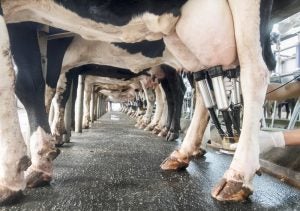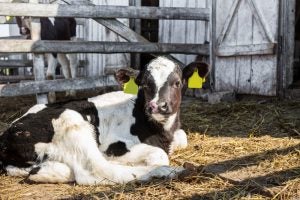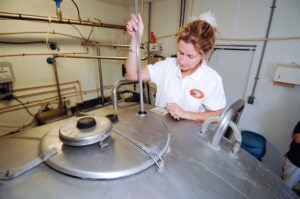It takes milk only around 48 hours to go from the cow to the grocery store, but it takes a lot of people to bring milk to your table, creating a big economic impact.
Here, we’ll journey through some of the jobs it takes to make delicious dairy products from start to finish!

In order to produce milk, we need to start with cows and calves. After calves are born, someone is in charge of taking care of them — and every farm has someone (or multiple people) in charge of calf care. These farmers feed the calves, monitor them, keep records about them, and work to make sure they are happy and healthy.
As these calves become full grown, they are then called bulls (male) and heifers (female.) When the heifers grow up to be about 12 to 15 months old, it will be time for them to be bred by a bull or through artificial insemination (AI.) If they are bred with a bull, it will take people to raise and transport that bull to where the heifers are (almost all dairy heifers are bred with AI.) With artificial insemination, it takes many different people to research, collect, test, and transport the semen, and also to breed the heifers.
It can take many people — both on the farm and genetic consultants — to decide which bulls to breed to which cows and heifers.

When it’s finally calving time, farmers and farm workers monitor the heifers and cows and provide assistance to some during calving. Then the whole process repeats itself!
But we’re not done.
Now it’s time to milk the cows. Before they can be milked, the milking parlor, bulk tank, and other equipment will have to be set up correctly; repaired when necessary and regularly inspected to make sure everything is safe and clean. While many farms used highly technical and automated robotic milking machines on their cows, many other farms hire additional people to help milk cows two or three times a day.
The cows will be bred again about two months after they have their calf and will continue to be milked for around 10 months. At this point they will be “dried off.” This just means that they will stop producing milk and will have about two months off before they have another calf to where the process starts again.
There are people in a few other jobs that help ensure dairy cows are well cared for. Veterinarians are necessary for any animals that are sick or injured and also to make sure farms have proper animal health plans in place. Cows also need their feet trimmed regularly by a professional. Cows are also visited by a nutritionist who makes sure they receive proper nutrition throughout all stages of their lives, which also takes people to grow crops and make their feed. The feed and any byproducts from other industries, such as distillers grains, also need to be transported to farms to feed cows.
That’s a lot of jobs, and the milk hasn’t even left the farm yet! After the cows are milked, milk collects in the bulk tank where it’s picked up regularly and transported to a processing plant. Before arriving at the plant, the milk is tested for antibiotics and any other possible contaminants, and if it’s found to contain even a trace, it is discarded.

After arriving at a processing plant and being tested again, the milk is finally ready to be turned into delicious dairy products.
Milk is pasteurized, homogenized, bottled, and transported to the grocery store in about 48 hours! There are also product tests, equipment repairs and a lot of record-keeping at the processing plant. The plants are also visited by inspectors.
These are just a few of the roles you can find in the dairy industry. Overall, the dairy industry in the United States provides over 3.2 million jobs and pays workers over $200 billion in wages. United States dairy provides over $794 billion in total economic impact, which is 3 percent of the United States GDP. Dairy is also growing, with wages for workers increasing by 11 percent in the last two years.
As you can see, dairy is incredibly important, not only for providing healthy, nutritious and delicious food, but also for providing many jobs and creating a huge impact on the economy. The world wouldn’t be the same without dairy products!
Michelle Miller, the “Farm Babe,” is an internationally recognized keynote speaker, writer, and social media influencer and travels full time to advocate for agriculture. She comes from an Iowa-based row crop and livestock farming background and now resides on a timber farm in North Central Florida.



